In the broadest sense of the word, there is something almost scientific to The Royal Art Lodge’s way of working: they ask themselves open questions, try to prove themselves wrong, and watch for the unexpected; and through systematic experimentation and observation their results are successful only in the degree to which they survive collective scrutiny. But unlike science, the proof of reproducibility is not their aim – their observations cannot be repeated, even though the artists meet regularly of a Wednesday evening to do their work. Like the nurses and their practice dolls, The Royal Art Lodge chop things up to look inside and see how they work, but having dismembered the body one cannot quite put it back together in the same way. Nevertheless, amidst the traces and fragments something appears suspended.
 |
| The Royal Art Lodge: Untitled 35, 15.24 x 15.24 cm, mixed media on panel, 2004; courtesy Douglas Hyde Gallery |
 |
| The Royal Art Lodge; CDEFGABC, 15.24 x 15.24 cm, mixed media on panel, 2004; courtesy Douglas Hyde Gallery |
The expanses of the Canadian prairie press in upon the group, but, to paraphrase Einstein, it is the monotony of this quiet life that stimulates the creative mind. The three minds here drawn together do not expand their horizons outwards: a matt background closes them in. Against this background a peculiar iconography is paraded, consisting of animals, ghosts, monsters, girls and dark woods: and within these cramped and obscure allegories a few recurrent qualities can be detected – solitude, dark humour, a love of incongruity and of all that is twee. Somewhere out of sight, one senses the machinations of a largely insensate nature twisting its way through a thousand small lives. Their melancholy stems from the now-deflated tradition of the hero at the sublime frontier.
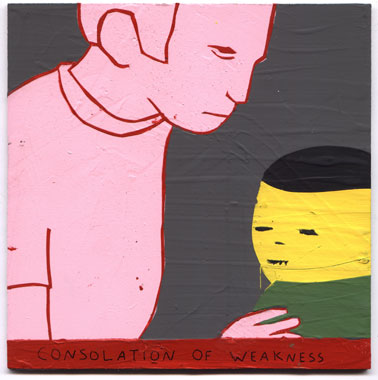 |
| The Royal Art Lodge: Consolation of weakness, 15.24 x 15.24 cm, mixed media on panel, 2004: courtesy Douglas Hyde Gallery |
Sometimes overly sentimental, their presentation is intimate and simple; child-like perhaps, but this affected naïvety is neither honest nor unpretentious – after all, can children not simply lie? And do they not often pretend? These works surely ask to be judged by how well their mendacity is carried off, or how well their artifice approximates a model of some broken, internalised nature pieced together in dreams, fables and half-insights.
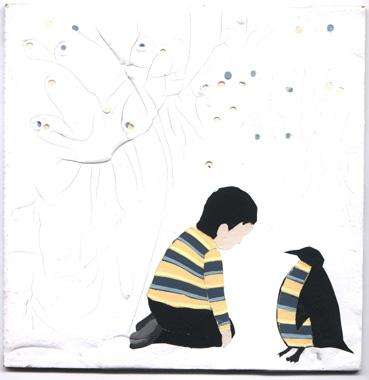 |
| The Royal Art Lodge: Untitled 33, 15.24 x 15.24 cm, mixed media on panel, 2004; courtesy Douglas Hyde Gallery |
Presented sequentially at eye level around the gallery walls, an interior monologue is developed: beasts speaking to one another; figures absorbed in their own activities, looking inward, caught in their function as an opaque cipher; forms and signs answering one another across the gallery. This private, isolated absorption is also demanded of the audience as they file along from image to image.
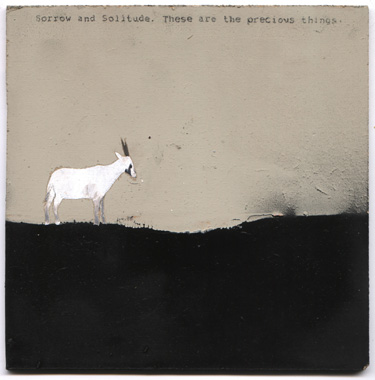 |
| The Royal Art Lodge: Sorrow and Solitude. These are the Precious Things, 15.24 x 15.24 cm, mixed media on panel, 2004; courtesy Douglas Hyde Gallery |
This is where, despite their quasi-scientific approach, The Royal Art Lodge show themselves to be romantics to the bone. “Sorrow and solitude. These are the precious things," we are told, but this sentiment belies their collective way of working. It means that the independence and openness that they have gained by collaborating with each other is reduced to the spurious independence of an isolated, self-sufficient individual: that is, the group presents itself and demands to be addressed not as a group but as an individual. Collaboration shows the private monologue of the self to be a collection of fragments determined collectively, but this insight is then effaced by recourse to the traditional set of relations between artist, artwork and viewer. Where, in their production, The Royal Art Lodge have shown the independence of their works to be the result of co-production, in the circulation of these works independence is again aligned with that of an isolated object.
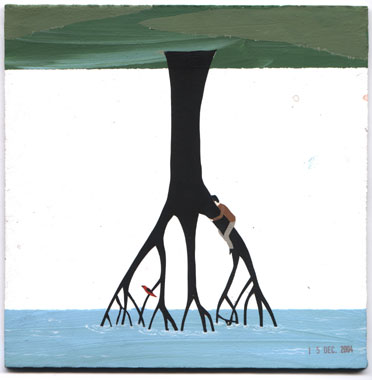 |
| The Royal Art Lodge: Untitled 32, 15.24 x 15.24 cm, mixed media on panel, 2004: courtesy Douglas Hyde Gallery |
Why not continue collaborative production into the processes of circulation and viewing, the audience adding their own twist to the narratives? In science, one often tests the results of some research by allowing them to be picked over by a rival, thus opening them up to the scrutiny of one’s peers. If The Royal Art Lodge is on the verge of dissolution, perhaps others could continue their work. A naïve aspiration no doubt, but hardly out of touch with the present line of enquiry.
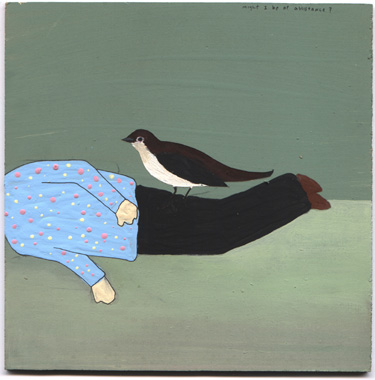 |
| The Royal Art Lodge: Might I Be of Assistance?, 15.24 x 15.24 cm, mixed media on panel, 2004: courtesy Douglas Hyde Gallery |
Tim Stott is a critic based in Dublin.